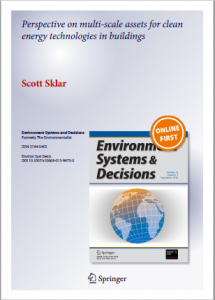The OurEnergyLibrary aggregates and indexes publicly available fact sheets, journal articles, reports, studies, and other publications on U.S. energy topics. It is updated every week to include the most recent energy resources from academia, government, industry, non-profits, think tanks, and trade associations. Suggest a resource by emailing us at info@ourenergypolicy.org.
Resource Library
91 to 100 of 343 item(s) were returned.
The 56 State and Territory Energy Offices’ investments in energy efficiency and renewable energy projects have grown over three decades, not only through cost-shared support for technology demonstrations and commercialization, but also through a variety of financing programs and mechanisms. Over the past several years, the number and scale of these public-private financing programs have grown; the total estimated investment stands at $3 billion in 2013, with significant additions expected in the coming year.
The types of financing tools used by State Energy Offices have evolved from revolving loan funds to
sophisticated credit enhancement mechanisms and new approaches to bond …
Energy management represents a significant opportunity for organizations to reduce their energy use while maintaining or boosting productivity. The industrial and commercial sectors jointly account for approximately 60% of global energy use. Organizations in these sectors can reduce their energy use 10% to 40% by effectively implementing an energy management system (EnMS).
The recommended knowledge and skills in this report may impart guidance to workforce programs under development, generate opportunities for collaboration among developing or expanding training programs, facilitate greater consistency among existing professional programs, and increase awareness about the energy efficiency potential that can be achieved through skills programs. …
View Full ResourceOptimizing high-value energy efficiency and renewable energy in multi-scale systems that include buildings provides energy savings, energy reliability, indoor health and power quality, among other benefits. These benefits are not easily accounted for in traditional energy budget analysis, and their monetization is not included in typical cost-benefit calculations. Popular belief is that higher use of energy efficiency reduces return on investment (ROI) and that inclusion of renewable energy further reduces ROI. In fact, optimization of higher degrees of energy efficiency with on-site renewable has significantly greater positive economics. This is due to several factors including the aging electric grid—statistically having …
View Full ResourceThis report investigates the market barriers and available solutions to dramatically increase the energy efficiency of buildings. Energy Efficiency in the Built Environment (EEBE) is a sector with an estimated market potential of $87 billion per year, and an equally substantial opportunity to reduce greenhouse gas emissions. In 2010, the Carbon War Room launched the Green Capital Global Challenge (GCGC) to help cities around the world use innovative mechanisms to support energy efficiency in their built environments, thereby bringing capital, energy technologies, and jobs to their citizens in a sustainable and profitable way. Having concluded the GCGC, we are now, …
View Full ResourceAmericans spend $432 billion a year powering their homes, stores and offices, on par with what US businesses spend on employee health insurance. United Technologies Corporation, in collaboration with the Rhodium Group, analyzed the impact of a 30% improvement in US building efficiency by 2030. We find that such an improvement is possible with existing technology and design practices and would generate $65 billion dollars per year in savings, net of investment costs, for American households, businesses and governments.
In corporate finance terms, investing in a 30% improvement in building energy efficiency would have an internal rate of return (IRR) …
View Full ResourceThis report compares energy efficiency policy in buildings in China, Germany, and the United States, providing the context for, and describing, policies in these three countries in order to lay the groundwork for future review of policy effectiveness.…
View Full Resource… View Full Resource
-
There were more than 4.8 million commercial buildings in the United States in 2003.
Space heating and lighting are the largest uses of energy in commercial buildings, representing 38 percent and 20 percent of total site use respectively.
The choice of electricity or natural gas use within the sector is dependent on building use, size, and geographic location.
Health care and educational buildings use natural gas more commonly than other commercial building types.
A large proportion of energy used worldwide is expended in the building sector. From a sustainability point of view, it is clear: to bring about a green society, we have to invest in green buildings. But do investments in green buildings pay off? From a micro per- spective, it may be clear: a house-owner installing a more efficient heating system is making a good investment, as the energy costs saved will pay for the investment and more. But is this also true from a macro perspective? What about investors planning to invest in green buildings directly or indirectly—does that pay …
View Full ResourceA large share of total U.S. energy consumption—40 percent—occurs in homes and buildings. Homes and buildings are less energy efficient than they would be if people could assess the value of energy savings more easily and correctly, and if energy prices provided them with stronger incentives to do so. This paper identifies three reasons why people undervalue energy savings: misperceived energy prices, imperfect information about energy efficiency, and biased reasoning about energy savings. The paper then examines four types of policy options for addressing those underlying market imperfections: prices that reflect the social costs of energy use, financial incentives, energy-efficiency …
View Full Resource